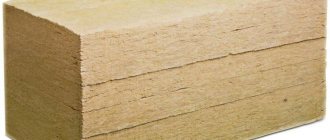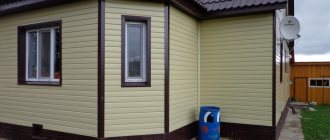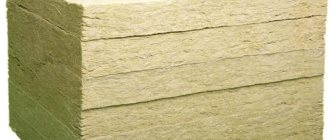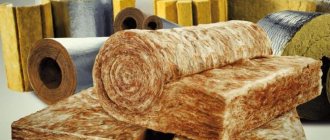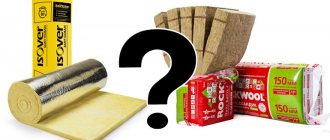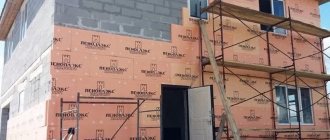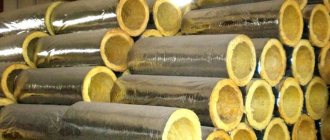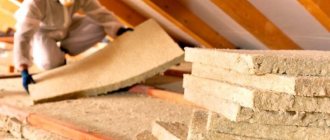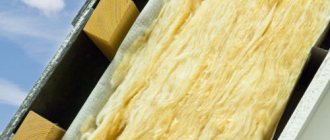The choice of mineral wool for building insulation is easily explained by its characteristics. But the issue of fire protection of a building is not inferior in importance to the problem of reducing heat losses. The consumer is concerned with the question of whether mineral fiber wool burns and what degree of fire safety its installation can provide. Using the characteristics, properties, component composition and features of production technology, we learn about the degree of fire resistance of representatives of this popular class of thermal insulation products.
Whether it burns or not, that is the question
Disadvantages of glass wool
Like other types of insulation, fiberglass insulation has disadvantages, which are often decisive when choosing another material.
Let's consider the negative characteristics of glass wool: Increased fragility of fibers
Working with glass wool requires enhanced protective equipment and caution. Even the slightest contact of glass dust with the skin or mucous membranes will provoke severe itching and an allergic reaction.
Thin and sharp tiny fragments of fibers also easily penetrate into the lungs and remain there for a long time, causing irritation and even swelling.
The need for reliable glass wool insulation. Especially when insulating internal walls. This drawback is directly related to the thinness and fragility of the fibers, particles of which can enter the room over time.
Instability in front of the sun's rays. Glass wool does not like to be in direct sunlight for a long time. They have a destructive effect on it. Therefore, it is important to protect the insulation layer from external influences.
Relatively short service life. Glass wool retains optimal thermal insulation qualities for approximately 10 years.
Fiberglass wool - does it burn or not?
The product consists of parallel fibers that are longer than other mineral analogues. This structure explains the special strength, resistance to vibration, and elasticity. And its low density (up to 45 kg/m³) allows it to be compressed up to 90%, making it elastic, soft, and capable of insulating surfaces with complex geometries. The durable, frost-resistant product keeps its shape and does not lose its thermal insulation properties over time. When in contact with metals it does not cause corrosive processes.
Cons of glass wool:
- fragility of fibers, due to which installation is carried out in protective equipment;
- volumetric shrinkage is possible during operation;
- moisture absorption can reach up to 20% of the sample weight, reducing its performance.
Product samples from a well-known European manufacturer
Now on to the topic of this section: can glass wool burn? The material belongs to the NG class, does not ignite and does not support combustion, and sinteres at +500–+550°C. But the upper temperature limit recommended by different manufacturers is in the range of 250-450°C. It is determined by its resistance to destruction of organic binding components.
Criteria for choosing glass wool
When planning to purchase this insulation, keep in mind certain nuances so that the glass wool is of high quality and lasts as long as possible:
First of all, pay attention to the packaging in which the insulation is stored. It must be strong and intact
It is highly recommended not to expose the material to atmospheric moisture or sunlight during storage. High-quality material has a light yellow color and a uniform structure. Consider the density and thickness of glass wool. The most common density is 11 kilograms per cubic meter. This insulation is optimal for insulating horizontal non-load-bearing structures: floors with joists, ceilings, roofs. For thermal insulation of pitched roofs, partitions and internal walls, material with a density of 15 kg/m3 or more is intended. If layered masonry is assumed, then it is best to use insulation with a density of 20 kilograms per cubic meter. For thermal insulation of external walls, staple glass fiber with a density of 30 kilograms per cubic meter is suitable. It is also recommended that the glass wool be cached with fiberglass. The latter will protect the fibers from blowing out and give the material additional strength.
«»
- , . , . , 2 : ;
- – : , , , . , , , .
- , 8-10 , «» .
3.
11/3. 2-3. . Isver.
15-18 /3 . . .
4. ,
:
- ;
- 0,5-1 . . . . , 2 , . .
20-30 /3 (Isover 100 //). . .
:
- , .
- .
- .
- .
- .
- , .
Where are the inspectors looking?
But they don’t look anywhere. That is, mineral wool is simply not tested for flammability. Absurd? Perhaps, but such, to put it mildly, strange phenomena in our country, unfortunately, sometimes happen.
So, in accordance with the old GOST, organic materials are exempt from flammability tests if they contain no more than 2% “inorganics”. Of course, in order not to create a headache for themselves, it is much easier for not particularly scrupulous manufacturers to write that in their mineral wool with “inorganics”, that is, those same binders, everything is OK, there are no more than 2% of them. But in fact - more, but no one will check this.
So it turns out that supposedly non-flammable mineral wool is initially exempt from all checks, but at the same time burns well in real fires. Well, that is, it passes (or rather does not pass) the test in practice...
Glass wool is used as insulation for:
- walls
- partitions
- roofs
- gender
When choosing insulation for your home, take a closer look at glass wool if:
- you have a large volume and a limited budget,
- the amount of work is small, but there are no assistants,
- I have experience working with mineral wool,
- ready to work strictly according to technology: vapor-proof membrane, special tape.
Let glass wool become your friend. You just need to learn how to prepare it correctly, or rather, use it.
Let's follow the news!
What types of mineral wool are there (types and materials)
It’s probably worth starting with what mineral wool is made of and why it’s called that. This soft insulation is made from glass, slag or stone. All these components are natural materials. In other words, these are minerals. This is where the name came from: mineral wool means it is made from a mineral, everything is simple here...
→Glass wool is made from glass. For its production, quartz sand or broken glass products are used. This material was widely used on construction sites in Soviet times. It is cheap in cost and has relatively good thermal insulation properties.
Mineral wool ISOVER
Mineral wool ROCKWOOL
Basalt wool KNAUF
But glass wool is very difficult to work with, especially in the hot season. You cannot do without a respirator, goggles and a special protective suit. Even if you use special overalls, you still cannot get rid of the itching on your body. I say this from my own experience, since I had to work quite a lot with glass wool in the mid-nineties. Anyone who worked with her will understand me.
→Slag wool is made from blast furnace slag (unburned coking coal residues). All its characteristics are almost the same as those of glass wool. Working with her is also unpleasant and problematic. Therefore, manufacturers have developed a more “advanced” version of mineral wool, which is now used everywhere.
→Rock wool is today the most practical and relevant soft insulation. Most often, hard rocks such as basalt are used as raw materials. Basalt wool does not crack like glass and slag wool and does not have more improved characteristics.
Roll insulation URSA
ISOBOX insulation boards
TECHNONICOL stone insulation
Don’t think that mineral wool contains nothing else. This is wrong. Various additives and fillers are used in production, which were not discussed here, since the technological process is presented figuratively and in general terms. By the way, in the future we will consider only stone basalt wool, since this is what is most often used at present, although there are exceptions.
Slag wool - flammable or non-flammable heat insulator
The raw material for production is blast furnace waste. The manufacturing technology is not fundamentally different from the methods for producing other representatives of products of this class. The main indicators - thermal conductivity, durability, hygroscopicity - are worse than those of glass wool. Added to the disadvantages is fragility and residual acidity of some components of the composition (with sufficient humidity it causes corrosion of contact metal surfaces). A cheap product, due to a combination of shortcomings, is losing its position in the construction market, so in practice it is becoming less and less common.
It cannot be said that slag wool is a reliable, fire-retardant material. It does not burn, but begins to melt at 250°C and sinter when the threshold of 300°C is exceeded.
Insulation of the attic with slag wool
Purpose and form of delivery
Finishing the thermal insulation of a house with siding There is a wide variety of glass wool products used for insulation, which are installed on the same principle as sound insulation.
Thermal insulation finishing is carried out:
- sheet metal (galvanized iron or aluminum);
- siding;
- clapboard;
- brickwork.
Fiberglass is produced for the following types of work:
- on external surfaces;
- on horizontal surfaces;
- on pitched roofs;
- on internal surfaces.
Each type of fiberglass differs from other types of material in its properties, and is optimally suited for a specific purpose. One is an excellent sound insulator, the other has a large heat capacity. Delivery forms: plate and roll. The slab is usually used for insulating small spaces. Rolls are designed for covering large areas.
The main criterion for selecting a fiberglass product is the thermal conductivity coefficient. Most often it is indicated on the packaging or labeling of the product. The lower this indicator, the better its insulating properties. The basic requirements for fiberglass must comply with GOST R 53237-2008.
Watch a video that clearly demonstrates how glass wool resists fire:
https://youtube.com/watch?v=2-Hm9rJefVE
Price list
Insulation of ventilation façade with cladding
| Name | Without insulation | 50mm | 100mm |
| – porcelain stoneware, rub/m2 | 3045 | 3330 | 3440 |
| – fiber cement panels, rub/m2 | 3175 | 3460 | 3570 |
| – metal cassettes, rub/m2 | 3415 | 3700 | 3810 |
| – Clinker tiles, rub/m2 | 5245 | 5530 | 5640 |
| – Aluminum cassettes, rub/m2 | 6860 | 7145 | 7255 |
| – Planken, rub/m2 | 4815 | 5100 | 5210 |
| – Composite cassettes, rub/m2 | 3520 | 3805 | 3915 |
| – Metal siding, rub/m2 | 2715 | 3000 | 3110 |
| – Profiled sheet, rub/m2 | 2215 | 2500 | 2610 |
| – Terracotta panels, rub/m2 | 7815 | 8100 | 8210 |
| – HPL panels, rub/m2 | 6860 | 7145 | 7255 |
| – Natural stone, rub/m2 | 6090 | 6375 | 6485 |
| Name / thickness of thermal insulation | 60mm | 80mm | 100mm |
| Turnkey installation of thermal panels lined with artificial stone, rub/m2 | 3300 | 3450 | 3550 |
Materials for thermal insulation of fireplaces
Special thermal insulation for fireplaces is used to minimize heat loss in all parts of the fireplace: the chimney, the stove mass and the firebox itself. This allows you to increase the efficiency of heating equipment. Insulation of different parts of the fireplace has the following goals:
Protects the chimney from the destructive effects of condensation that forms during a sudden change in temperature. The aggressive effect of condensate is due to the moisture content, various acids formed during combustion and carbon dioxide. Where the pipe passes through the ceiling, special care should be taken to comply with fire safety standards
If wooden building materials are used, special care should be taken to protect the surface of the ceiling. High temperature insulation in fireplaces is used to create a directed flow of thermal energy to warm people sitting across from it.
For these purposes, infrared reflectors are used, which are installed in the firebox itself. Protection of wall structures using a heat-protective layer. Otherwise, a brick wall can quickly become unusable due to a sharp temperature change, and a wooden wall can catch fire.
The building materials used for thermal insulation of the fireplace are represented by the following groups:
- containing stone fibers (Rockwool, TEXHO T80, PAROC FPS 17) – are produced in the form of slabs and have a foil coating on one of their sides, which allows them to withstand temperatures of several thousand degrees;
- based on silica obtained from quartz sand and alumina, produced in the form of flexible plates;
- Superizol - is made using calcium silicate and has good thermal insulation qualities, suitable for insulating fireplace bodies and their chimneys, attached with glue or self-tapping screws;
- Vermiculite – presented in the form of slabs (Scamol, Thermax), consists of compressed grains of the substance, is rigid, easy to saw, and has a surface suitable for finishing;
- Supersil - is a fabric made of silica with a layer of foil, has a high cost;
- gypsum fiber - obtained by mixing and pressing gypsum and cellulose, suitable only for insulating solid fireplaces, floors and walls, does not withstand loads and is deformed.
When choosing materials, it is important to make sure that they are environmentally safe so that they do not release toxic substances into the environment when heated
Disposal
Glass wool can be obtained by recycling cullet. How is it disposed of?
Today there are three options :
- Burial in special landfills.
- Grinding in pure form and reuse in road construction, brick production.
- Used in the form of a charge - a solid residue formed during the combustion of waste. In this case, the glass component can reach 78% of the total volume, almost 20% is clay, 2% is sodium silicate.
The price of recycling services for recycling glass wool ranges from 400 to 1,000 rubles per ton .
There are also installations (mills) for processing (deep grinding to sizes of 0.1 - 100 microns) industrial waste glass fiber and its return to the technological process.
Brands of non-flammable mineral wool
Thermal insulators with fire retardant properties are produced by many brands. But for quality, confirmed by certificates and construction practice, they often choose products from the following manufacturers:
- ROCKWOOL is a well-known Danish company that produces popular, high-quality products capable of providing fire-resistant protection for various structures made from classical building materials, steel and reinforced concrete for 2.5-4 hours.
- URSA is a Spanish-German company, the main competitor of ROCKWOOL. Produces high-quality samples from glass fiber of the NG group (non-combustible materials).
- KNAUF is a German company. Materials, kits and systems for construction work are the manufacturer's products. Mineral wool insulation is only one of the lines in the total volume of products. This explains their small range. But the quality of the product is decent.
- ISOVER is a well-known brand of insulation products from an international industrial corporation.
- PAROC is a brand of Finnish origin. Energy-efficient, fire-safe boards are a product that the manufacturer has focused on producing. The products are always distinguished by their quality.
- The quality of products from domestic brands ISOROC and Technonikol does not lag behind foreign brands. In the competitive struggle, they have an advantage - more affordable prices.
Fireproof insulation from well-known manufacturers
Compound
What is glass wool made of? This material contains both the main components that provide its properties as insulation, and binders that allow it to maintain strength and integrity.
Basic:
- glass or broken glass;
- natural quartz sand;
- limestone (chalk);
- soda ash;
- boric acid;
- borax (sulfate);
- dolomite;
- fluorite
Binders:
- polymer resin;
- clay;
- spar;
- other substances.
Binder components can make up 2.5 - 10% by weight.
The question that some people have, why there is glass in glass wool, can be answered as follows. The presence of this component determines the important properties of the material, namely:
- non-flammability;
- unattractive to rodents and mold;
- strength and durability.
If instead of glass wool there were, say, wood fibers in glass wool, all these advantages would be reduced to zero.
Application area
Whatever surface is covered by basalt non-flammable products, in addition to thermal insulation protection, the creation of a protective barrier against the spread of fire in this area is also guaranteed. The main areas of application of the fire-resistant product:
- Floor coverings of any buildings erected from various building products. Insulation will cost more, but the degree of fire safety of each level of the building increases significantly.
- Wooden buildings: log houses, houses made of timber, frame and frame-panel structures, buildings with wooden cladding and decor.
- Saunas, bath complexes.
- Prefabricated country houses made of flammable products.
- Industrial, civil buildings to meet the required safety standards.
- Gas pipelines, pipelines with explosive transported media.
- Buildings with a lot of people.
- Protection of the route of power supply cables.
- Any buildings that are located dangerously close to fire hazardous objects.
- Protection of any communications made of materials with low resistance to fire and high temperatures.
- Insulation of heating system elements.
- Protection of components, parts, communications of industrial equipment.
One of the options for use is chimney protective insulation
Protection from a non-flammable product not only protects the surface covered with it. In the event of a fire, the product will contain the fire for some time, giving a chance for timely evacuation of people. At the same time, in a high-temperature source, the product will not become a source of emissions harmful to human health, which cannot be guaranteed by other synthetic heat insulators.
All mineral wool insulation differs little in appearance or structure, has common indications for use, and is similar in installation technology. Their main difference is the level of fire resistance. A competent, conscious choice of non-flammable types of products will increase the level of fire resistance of the structure, in an emergency it will slow down or stop the spread of fire, and will provide additional minutes to save human lives.
What affects the fire resistance of stone heat insulators
The product, naturally, owes its fire-resistant abilities to the raw material - non-combustible rock of volcanic origin. Due to the difference in the proportional composition of rocks from different deposits, their melting point may differ, but is still considered very high. For basalt this is 1100-1250°C. Also, the durability of the insulation is affected by the possible reduction or elimination (replacement with others) of bituminous or synthetic binders.
Samples of used rocks
Note! Basalt stone wool should not be considered 100% fire protection. Even its unique fire resistance, as well as its ability to withstand intense heat, will not help when the load-bearing structures begin to collapse.
DIY house facade decor ideas
Decorating the facade of a house is an individual task for each owner. Some will opt for traditional plaster or frame framing. The more progressive part will use design solutions for decorating with stucco. Currently, facades of houses with a bay window are in demand.
A bay window is a part of the facade protruding beyond the plane of the wall, fully or partially glazed. To decorate this part of the building, stucco molding is used, which frames the entire perimeter of the glazing. You can install two decorative consoles under the bay window; it will look like a box in a theater.
Everyone can find a way to decorate the facade of a house with their own hands. To do this, you can use catalogs in magazines or specialized websites on the Internet.
Strict adherence to technology is the key to safety
When deciding whether or not to use mineral wool in your home, there is one important thing to consider. Stone wool is a heat and sound insulator, not a decorative coating. Consequently, it is installed inside the wall, under the floor, above the ceiling, and not directly in the living space. Both for external wall insulation and for internal installation technology, it is necessary to insulate the insulation layer from moisture and blowing. Proper insulation also serves as protection against harmful substances entering the air at home.
For example, for internal insulation, a layer of wool is fixed on top of a brick wall, then plasterboard panels are installed. Additionally, a film for protection against moisture or a heat-reflecting foil gasket can be used. Mineral wool slabs can be produced with a coating of aluminum foil, kraft paper, or fiberglass. After installing the plasterboard panels, all seams are carefully sealed, then the walls are painted or covered with wallpaper. The insulation is securely “packed” into the wall, almost hermetically sealed inside. The quality of this insulation determines not only the purity of the air, but also the preservation of heat in the house, dry walls and protection from mold.
Often problems arise after the construction of the building is completed, when alterations begin during operation - moving door frames, constructing arches, built-in wardrobes, installing air conditioners, hoods, etc. These changes are sometimes carried out so poorly that mineral wool ends up in ventilation ducts and sticks out of the walls in built-in closets. Naturally, this can be harmful to health. The blame for this should not be on the “harmful” material, but on your own incompetence.
Strict adherence to the technology for laying stone wool, high-quality processing of the seams of insulating panels and proper operation of the building in the future are a guarantee of safety.
Conclusion: In order to completely eliminate harm from basalt wool in the process of working with it and during the operation of the building, you should use only high-quality certified materials produced in compliance with all standards and carefully follow the recommended installation technology. They don't skimp on their health. It is better to buy expensive insulation from a well-known company (Knauf Insulation, ROCKWOOL, ISOVER) than to think about whether the substances released into the air from the insulation affect the body or not.
Leading manufacturers of thermal insulation materials use high-quality raw materials of natural origin, as well as high-quality new generation resole resins, which are present in the final product in a solid, infusible and insoluble state, which reduces to zero the likelihood of harmful substances being released from mineral wool.
In European countries, mineral insulation has been used for decades and, despite high environmental requirements, is recognized as a suitable technical solution. Constant control over production processes allows us to obtain high-quality material that meets European and world quality standards.
Other materials on this topic:
- Foam plastic for insulation: pros, cons, safety
- Expanded polystyrene for internal insulation. Is it possible or not?
- 7 most popular natural insulation materials for the home
- Stone wool: how dangerous is this insulation to health?
- We insulate the house. Why can’t you insulate walls from the inside with polystyrene foam?
Other materials on this topic:
- Foam plastic for insulation: pros, cons, safety
- Expanded polystyrene for internal insulation. Is it possible or not?
- 7 most popular natural insulation materials for the home
- We insulate the house. Why can’t you insulate walls from the inside with polystyrene foam?
- < Back
- Forward >
Basalt wool is a suitable insulation material
This product is obtained from melt products of volcanic rocks. It is distinguished by the lowest thermal conductivity coefficient - 0.035-0.045 W/(m•K), chemical neutrality, greatest strength, good sound-absorbing and water-repellent properties, increased durability, safety, and low weight. The slabs quickly restore their shape after deformation and do not shrink. The installation process can be carried out without protective devices - the fibers do not splinter. The insulation is universal, the possibilities of application are practically unlimited.
It is believed that some of the substances contained in the composition may be harmful to health, since they are based on phenol-formaldehyde resins. But phenol and formaldehyde are toxic and flammable only in a free state. In this case, they are bound (the binding resins are in an inert state), their quantitative content - less than 2% of the total mass - does not exceed established sanitary standards. The destruction of binding additives with the release of phenol vapor occurs at 600-700°C. The volume and concentration are so small that they cannot be considered more harmful than a single car exhaust. Poisoning can most likely occur from combustion or smoldering products of other surrounding objects.
More details about the properties of stone wool - advantages and disadvantages - in comparison with popular polystyrene foam:
The following facts speak about basalt products as the best fire protection:
- does not burn;
- melts at temperatures above 1100°C;
- products included in the fire protection belt can provide up to 240 min. high-quality fire protection;
- the operating temperature range can reach 600-700°C. Then, with the possible destruction of the binders, the product may disintegrate into hot dust.
Flammability test. A clear demonstration of the resistance of high-quality high-density basalt wool to open fire (temperatures above +1000°C):
Benefits and safety
Main characteristics of glass wool:
- long fibers;
- product density ranges from 11 to 45 kg/m3;
- high resistance to mechanical loads (depending on density);
- thermal conductivity of glass wool ranges from 0.032 to 0.044 W;
- high sound insulation properties;
- non-flammable material, non-flammable class A1;
- maximum operating temperature 230 °C;
- fire resistance;
- melting point 700-1000 °C;
- high elasticity of the material;
- high tensile strength;
- resistance to mechanical damage during transportation.
Many people often ask the question: does glass wool burn? Due to its structure and very high melting point (over 1000 C°), glass wool does not burn and is an ideal fire protection. This excellent property of a non-combustible material is widely used in various industries; cotton wool is used as insulation and insulating material for walls, pipelines, containers and various structures. Therefore, to the question: does glass wool burn or not, the answer is obvious.
Like any building thermal insulation material, glass wool has pros and cons. Let's briefly analyze the positive and negative aspects.
Key benefits:
- low price;
- easy to cut with hand tools;
- flexibility and softness allows you to lay it in any hard-to-reach place;
- does not burn, reacts poorly to high temperatures, does not deform;
- wide choice of sizes and densities;
- high compressive strength;
- high resistance to significant tensile loads;
- low weight.
Significant disadvantages:
- moderate durability;
- gradually absorbs water;
- over time, it decreases in volume and crumbles;
- adversely affects the respiratory system;
- the need to carry out work only in special clothing with the mandatory use of protective equipment.
Fiberglass-based insulation not only maintains a comfortable room temperature in winter, but also provides thermal protection in summer. Glass wool insulates pitched roofs with linear pillars, which helps retard the transfer of heat from the outside to the inside of the building.
The scope of application of glass fiber is very wide: construction, manufacturing, heat supply, transportation of liquids, automotive industry, aviation industry. This is due to high thermal resistance - the ability of the material to accumulate heat, depending on density.
Fiberglass Manufacturing Standard
Working with fiberglass is determined by a number of state quality standards where GOST 19170 2001 is considered the main one. This regulatory document is an international standard for the production of fiberglass and structural fabrics. The standard describes manufacturing methods, scope of use and labor protection measures when working with fibrous insulating materials that contain glass dust.
Advantages and disadvantages
All representatives of this group of thermal insulation are characterized (to varying degrees) by the following positive properties:
- high heat and sound insulation characteristics;
- the product supports air exchange and prevents the formation of condensation;
- durability;
- ease of operation, ease of installation;
- fire and environmental safety;
- light weight;
- does not attract rodents, insects, and is not a favorable environment for the proliferation of microorganisms;
- versatility.
Let's also note the disadvantages - ability to absorb moisture, price.
Right choice
The choice is based on the scope of application of the insulation. Thus, basalt wool is relevant for insulating roofs, walls, ceilings and facades, as fire protection for ventilation and building structures, pipelines, baths and saunas. Foam glass is an excellent non-flammable insulation for chimneys; it is appropriate to use it for insulating roofs, walls, ceilings and fire-resistant structures.
If you want to insulate an apartment with foam glass, then you need an L-shaped bracket, an anchor, which will help secure a layer of blocks to the plastered wall (ceiling). Fiberglass is applicable for insulating attics, roofs, walls, floors along joists, partitions and interfloor ceilings, saunas and baths, walls behind radiators of central heating systems.
A little about brands
The most well-known manufacturers of non-combustible insulation are companies such as Rockwool, Ursa GEO, Technonikol, Light Butts.
To insulate the premises of construction sites, pipelines, ventilation ducts of engineering communications, both flammable and non-flammable insulation materials of various types are used.
The definition of non-flammable fire-resistant insulation is given by GOST 30244-94, which indicates that such a material, when exposed to an ignition source, burns with an open fire for no more than 10 s, and when tested in a laboratory oven loses no more than 50% of its mass, creating a temperature increase in it of no more than 50 ℃.
All insulation materials that do not satisfy at least one of the listed conditions are classified as flammable, non-fire-resistant materials.
Types of Fire Resistant Thermal Insulation Products
Unlike combustible types of insulation, such as sawdust, mats made from wood processing waste, used due to their rapid destruction under the influence of moisture only inside buildings, many types of fire-resistant thermal insulation materials are also used when installing curtain wall systems, in external wall panels outside construction sites.
There are several main types of fire-resistant insulation, divided depending on their area of application:
- For walls, floors of both wooden houses and construction sites built from brick, ceramic blocks, ready-made reinforced concrete, monolithic structures, including those made of fire-resistant (fire-resistant) concrete. In such cases, both traditional mineral wool and more modern fire-retardant basalt material, which does not absorb moisture and is non-flammable, are used in the form of rolls, mats, and slabs.
- For chimneys, heating stoves in residential buildings, and baths, non-flammable foil material made from various types of mineral wool is most often used, which has an increased coefficient of reflection of thermal energy from a layer of metal foil. And also due to the increased density of non-flammable insulation, used for these purposes as filling the thermal insulation areas of the floors adjacent to the chimneys; elements of fire-fighting cuttings, indentation.
- For thermal insulation and fire protection of metal structures of ventilation air ducts; sections of pipeline networks, both transporting coolants, including water, and flammable liquids, gas mixtures.
- For an engine, motor vehicle, railway vehicle, river/sea vessel/ship, stationary heat-generating, electricity-generating installations, both to limit the consumption of thermal energy, heating of adjacent structures, compartments, and as reliable sound insulation, cutting off loud noise from operating machines and mechanisms.
- For filling internal voids in the structures of fire partitions, fire-resistant gates, doors, hatches used to protect openings in construction barriers to fire and smoke flows, which allows them to increase their fire resistance to the values required by fire safety standards.
This division into types is quite arbitrary, because most roll, slab, sheet fire-resistant insulation, in contrast to bulk, liquid foaming heat-insulating materials that are not subject to combustion, can be used for thermal and sound insulation of both the premises of construction sites, areas of their utility lines, and engine compartments of vehicles, heat and power generating units.
Technical insulation URSA
1180 RUR/m3
1850 rub./m3
2350 rub./m3
900 rub./m3
1750 RUR/m3
1750 RUR/m3
on request
on request
on request
Features of Ursa technical insulation when purchasing
Low thermal conductivity.
An effective thermal insulator with high practicality - Ursa thermal insulation. An affordable price and proper installation make it possible to reduce up to 78% of the total heat loss of the pipeline in winter and rationally use energy resources - all this with minimal investment!
Excellent sound absorption.
Thanks to the chaotic structure of glass fibers, the material has excellent acoustic properties, protecting against noise and vibration. Therefore, it will be beneficial to buy Ursa thermal insulation to reduce sound and noise pollution.
Fire safety.
Fiberglass technical insulation can withstand temperatures up to 400° C without losing its properties, reliably protecting insulated structures from fire. The fiber does not burn, therefore Ursa thermal insulation can be used as fire protection in facilities with moderate temperature conditions. The price of the products is affordable even for small enterprises.
Flexibility and resilience.
URSA slabs and mats adhere perfectly to the insulated surface without gaps or leaks, which eliminates the possibility of the formation of cold bridges.
Compression.
Ursa insulation, which is the best priced this season, can shrink up to 60% and fully recover its shape after unpacking, which guarantees favorable savings on transportation and compact storage.
Easy installation.
The light weight and convenient dimensions of URSA insulation allow installation without the use of specialized equipment and with virtually no waste.
100% environmentally friendly.
The products of the URSA plant are safe for human health and nature, which is confirmed by certificates of compliance with the requirements of GOST and European eco-standards CE-Mark.
Durability.
For all brands of industrial thermal insulation URSA GEO and URSA TERRA, the manufacturer provides a warranty for a period of 50 years from the date of production.
Main areas of use of URSA thermal insulation
Fiberglass thermal insulation is recommended for insulation:
air ducts
— in order to reduce background noise from the operation of the ventilation system, increase the fire resistance of air ducts, maintain constant temperature indicators of conditioned air and prevent the formation of condensation, Ursa Geo thermal insulation and technical mat URSA TERRA 34 RN are most often used.
For pipelines
Ursa thermal insulation is used to reduce heat losses, ensure the desired temperature of the coolant, protect against condensation, freezing of pipes and prevent emergency situations in winter. Fiberglass technical insulation is recommended for thermal insulation of surfaces with temperatures from -60 to +320 °C.
industrial equipment
– during installation and operation to reduce energy losses and ensure optimal temperature of machines and units, tanks and heat exchangers. In addition, Ursoy pipeline insulation ensures worker safety and protection from thermal burns.
When is a ventilation gap still necessary?
In what other cases will you need a ventilation gap between the wall and the decorative covering:
- The material of the decorative layer promotes the formation of condensation.
- The wall material under the decorative layer can deteriorate from moisture (rot, cracks, etc.).
Otherwise, all the moisture that will condense on the inner surface of the corrugated sheet will be absorbed, which will be destroyed as a result.
In the case of a ventilation gap, moisture, of course, condenses on the inner surface of the profiled sheet - this is metal. But it does not have direct contact with the surface of wooden walls. And the air current that is present in the ventilation gap carries away this moisture in the form of steam and removes it from the space between the decorative layer and the wall.
Consider which of the above cases is yours and choose whether you need a ventilation gap or not. See what kind of wall material you have.
- Question: Good afternoon, dear gentlemen! Please tell us how best to decorate the outside of a house made of expanded clay concrete blocks (ECB), what façade would be appropriate here, what materials can be used?…
- Recently, people have begun to give preference to wooden houses. The first thing that attracts this natural material is its environmental friendliness. In addition to this, the tree is very good...
- This page shows a sectional view of a frame wall along with insulation, which is mounted between the frame posts. Simply put, a frame wall in cross-section looks like this...
- If you look at the history of the construction of residential buildings in cold regions, insulating walls with sawdust began to be practiced not so long ago. Sawdust as wall insulation during construction...
- The simplest design of the walls of a frame house is vertical posts connected by upper and lower frames and tied with jibs for additional structural rigidity. When using slab…
The ventilation gap in a frame house is a point that often raises many questions among people who are involved in insulating their own home. These questions arise for a reason, since the need for a ventilation gap is a factor that has a huge number of nuances, which we will talk about in today’s article.
The gap itself is the space that is located between the sheathing and the wall of the house. A similar solution is implemented using bars that are attached on top of the wind barrier membrane and on the external finishing elements. For example, the same siding is always attached to bars that make the facade ventilated. A special film is often used as insulation, with the help of which the house, in fact, is completely wrapped.
Many will rightly ask, is it really not possible to just take and attach the sheathing directly to the wall? Do they just line up and form an ideal area for installing sheathing? In fact, there are a number of rules that determine the necessity or unnecessaryness of organizing a ventilation facade. Let's figure out whether a ventilation gap is needed in a frame house?
Brief instructions for installing glass wool
Laying glass wool is quite simple, even alone. You don't need any special tools for this. The only thing that is required is reliable protection of the respiratory system, eyesight and skin.
We install glass wool according to the following instructions:
- We install a wooden frame on the surface. A timber with a cross section of 3x5 centimeters is suitable.
- After installing the sheathing, we cut the glass wool using a construction knife.
- Having crushed the material, we place it in the frame. It is not necessary to use additional fasteners, since the insulation itself will expand and fill the space if installation is carried out correctly.
- We glue the joints with tape or fill them with foam.
- Cover the glass wool with a vapor barrier film.
- Reinforcement and plastering can be done on top of the thermal insulation layer.
Glass wool is a reliable insulation material that was most widely used during the Soviet era. Nowadays, the popularity of the material has decreased somewhat, but it is still actively used due to its excellent thermal insulation qualities. The composition of glass wool is environmentally friendly and does not harm health if you use personal protective equipment when working with it.
Use of other insulation materials
Despite all the noticeable advantages of mineral wool, other insulating materials are often used. For example, ecowool is a fairly new material in our country (it has become widespread only in the last decade, although it has been used in the USA since the 70s of the last century). How does this material differ from mineral wool and is vapor barrier necessary when insulating with ecowool?
Ecowool consists of fluffed cellulose fibers that absorb moisture from warm air, however, the air between the fibers remains dry. Unlike mineral wool, it can withstand a change in humidity of 24% and still retain its insulating properties.
Thus, insulation using ecowool does not require vapor barrier.
Let's consider another popular insulation material - expanded polystyrene, or simply polystyrene foam. They can insulate a room both outside and inside.
When performing external insulation, there is no particular point in using a vapor barrier: the foam itself insulates it quite well. The only thing you have to do is to maintain the correct technology for attaching polystyrene foam, depending on what material, breathable or not, your structure is made of.
Is a vapor barrier necessary when insulating with polystyrene foam from the inside? Yes, it is absolutely necessary, since the “dew point” moves inside the room, there is a high probability of the walls getting wet and, as a result, the development of mold and mildew on them.
If the vapor barrier is done well, warm air will not reach the walls, and therefore there will be no risk of getting wet. It is also necessary to ensure good ventilation of the room.
The video below explains in detail why vapor barrier walls are needed. An example of a thermal engineering calculator is given, showing the effect of the arrangement of wall layers on the dew point and thermal insulation.
What mineral wool is needed in different cases?
When choosing insulation, it is also important to consider the climate of your region. For example, for walls in areas with a temperate climate, sheets with a thickness of 80 to 100 millimeters are well suited
When the climate shifts towards the continental, monsoon, subarctic, marine or arctic zones, the thickness of the mineral wool should be at least 10 percent greater. For example, for the Murmansk region, insulation from 150 millimeters is best suited, for Tobolsk - 110 millimeters. For surfaces without load in the horizontal plane, a thermal insulation material with a density of less than 40 kg/m3 would be appropriate. This mineral wool in rolls can be used for ceilings or for floor insulation along joists. For external walls of industrial buildings, an option with a coefficient of 50-75 kg/m3 is suitable. Plates for a ventilated facade should be chosen that are denser - up to 110 kilograms per cubic meter, they are also suitable for siding. For plaster, it is desirable to use façade mineral wool with a density of 130 to 140 kg/m3, and for a wet façade – from 120 to 170 kg/m3.
Roof thermal insulation is carried out at heights, so the small mass of insulation and ease of installation are important. Mineral wool with a density of 30 kg/m3 meets these requirements. The material is laid using a stapler or directly into the sheathing using a vapor barrier. In both cases, the insulation layer on top needs finishing. The choice of floor insulation depends on the characteristics of the selected finish. For example, for sheet materials in the form of laminate or boards, thermal insulation with a density of up to 45 kilograms per cubic meter is suitable. A small indicator is quite appropriate here, since there will be no pressure on the mineral wool due to its placement between the joists. You can safely lay thermal insulating mineral material with a density of 200 kg/m3 under a cement screed. Of course, the cost of such insulation is quite high, but it fully corresponds to the quality and ease of installation.
Real cases of fires in buildings with mineral wool
Fires in buildings insulated with mineral wool occur frequently, and insulation does not prevent the spread of fire. The reason for this may be the poor quality of the material. Mineral wool is often covered with cladding that does not meet fire hazard requirements, and the flammability of the insulation in these cases increases. This is also facilitated by gluing mineral wool to surfaces with compounds with low fire resistance.
A fire with a fire area of 1.5 thousand m² occurred in Moscow. It took more than 1.5 hours to extinguish it. The fire was caused by the ignition of a heat insulator. Welding work on the roof of the Rublev shopping center in Irkutsk caused a fire in the mineral insulation. The fire area was only 20 m², but more than 100 visitors had to be evacuated from the shopping center. In the Kaliningrad region, a fire crew went to extinguish the insulation of a heating main: the fire spread to mineral wool from grass burning near the pipeline.

